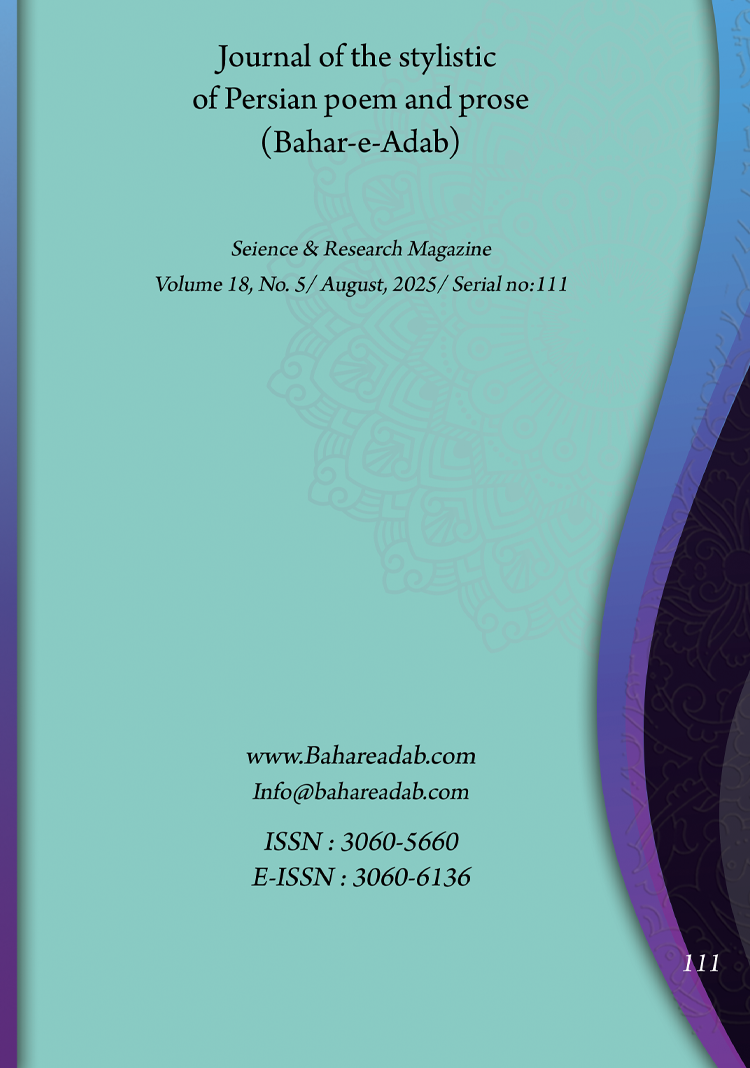- Count View : 17
- آدرس کوتاه شده مقاله: https://bahareadab.com/article_id/1857
- کد doi مقاله: Doi: 10.22034/bahareadab.2025 .18 .7893
Journal of the stylistic of Persian poem and prose
volume Number 18،
number In Volume 5،
،
issue Number 111
Mystical Perspective on the Dream of Prophet Abraham (peace be upon him) in the Chapter of Isaac
Zahra Ghaffari , Abdolreza Seif (Author in Charge), Homeira Zomorrodi
Abstract
BACKGROUND AND OBJECTIVES: Prophet Abraham"s (peace be upon him) vision in the Fass al-Isḥāqī of Ibn ʿArabī"s Fuṣūṣ al-Ḥikam is not merely a dream, but an expression of profound mystical vision and divine revelation. The vision is a manifestation of divine love, unadulterated submission, and the station of khulla (close friendship with God), indicating the inward journey of the seeker from multiplicity to unity. The purpose of this study is to provide an epistemological and mystical exegesis of the dream in terms of the doctrines of Ibn ʿArabī, namely those on theophany (tajallī), dream interpretation (taʾwīl), and waḥdat al-wujūd (unity of being).
METHODOLOGY: The research utilizes an analytical-interpretive approach based on library materials and mystical texts, focus on Ibn ʿArabī"s metaphysics on Abraham"s visionary experience.
FINDINGS: The dream of Abraham in this chapter is existential and epistemological, rather than allegorical or ethical, and reveals the fundamental principles of unity and divine truth through mystical hermeneutics. Ibn ʿArabī presents the dream as a way of intuitive knowledge, closeness to God, and rising above the bounds of reason and form. The khulla station is here shown to be the culmination of annihilation (fanāʾ) in divine love.
CONCLUSION: Abraham"s dream in the philosophy of Ibn ʿArabī is a point of convergence between vision, intuition, and ultimacy of truth. Through interpretive mysticism, it is a life to attain the oneness of the Real and creation and bring the seeker to utter oneness and annihilation of the self.
Keyword
Prophet Abraham’s Dream
, Unity of Being
, Mystical Journey
, Station of Khulla
, Ibn ʿArabī.
- The Holy Quran.
- Bahrami, M., & Kazemkhanlou, N. (2025). A comparative study of the image of Iblis in Mantiq al-Tayr by Attar and Tafsir Abu al-Futuh Razi. Journal of Persian Poetry and Prose Stylistics (formerly Bahar Adab), 18(108), PP. 1–18.
- Balkhi (Rumi). (2000). Masnavi-ye Ma’navi. Tehran: Negah Publications. Book 3, Section 98.
- Corbin, H. (1979). Earth of the Kingdom of Heaven (S. Z. Dehshiri, Trans.). Tehran. p. 213.
- Corbin, H. (2005). Creative Imagination in the Sufism of Ibn Arabi (Dr. Rahmati Insha’Allah, Trans.). Tehran: Nil Publications. p. 322.
- Davoudi-Moghaddam, F. (2020). An analysis of the theme of love in the mystical tales of Kashf al-Asrar. Persian Prose and Poetry Stylistics Monthly (Bahār-e Adab), 13(5), PP. 221–238.
- Deylami, H. ibn M. (1992). Irshad al-Qulub (Vol. 1). Qum: Al-Sharif al-Radi.
- Hafez Shirazi, M. S. al-D. M. (2004). Divan of Ghazaliyat (K. K. Rahbar, Ed.). Tehran: Mervi Press. Ghazal 493.
- Ibn Arabi, M. (1876). Al-Futuhat al-Makkiyyah (Vol. 3). Bulaq. pp. 508–509.
- ----------------. (2016). The Role of Imagination: Ibn Arabi’s Views on the Role of the Imagination (M. M. al-Ghorab, Ed.; M. Farahmand, Trans.). Tehran: Farayan Publications. p. 9.
- Izutsu, T. (1999). Sufism and Taoism (M. J. Gohari, Trans.). Tehran: Rozaneh Publications. pp. 28–31.
- Kashani, ‘A. R. (1903). Commentary on Fusus al-Hikam. Cairo. pp. 84–86.
- Kashani, ‘I. al-D. M. (2010). Misbah al-Hidayah wa Miftah al-Kifayah (J. al-D. Homaei, Ed.). Tehran: Dayereh-ye Sefid Publishing. p. 171.
- Khwarazmi, H. (2000). Sharh-e Fusus al-Hikam [Commentary on Fusus al-Hikam] (H. Hasan-zadeh Amoli, Ed.). Qom: Islamic Propagation Office of the Seminary of Qom. p. 373.
- Majlesi, M. B. (1403 AH). Bihar al-Anwar (S. I. al-Miyānajī & M. al-B. al-Bahbudi, Eds.), 3rd revised ed., Vol. 12. Series: Shi‘a Hadith Sources – General Section. p. 35.
- Mansouri Larijani, E. (2022). Translation and Commentary on Fusus al-Hikam of Ibn Arabi. Qom: Boostan Ketab Publishing. pp. 172 and 182.
- Movahhed, M. A., & Movahhed, S. (2019). Introduction, Translation, Explanation, and Analysis of Fusus al-Hikam of Ibn Arabi. Tehran: Setareh Sabz Publishing. pp. 350, 356, and 381.
- Mousavi, S. M., et al. (2006). Sleep, dream, and revelation from the perspective of Ibn Arabi. Religious Sciences Quarterly, 14(61), pp. 49–60.
- Nasafi, ‘A. al-D. (1993). Insan al-Kamil [The Perfect Man] (H. Corbin, Intro.; S. Z. Daheshiri, Trans.). pp. 44 and 114.
- Qaysari, D. (1882 CE / 1299 AH). Sharh Fusus al-Hikam of Ibn Arabi. Bombay. p. 25.
- Razi, N. al-D. (2010). Mersad al-‘Ibad (M. A. Riāhi, Ed.). Tehran: Ata Publishing. p. 171.
- Rumi, J. al-D. M. (2016). Divan of Shams Tabrizi. Qom: Melina Publishing. Ghazal 151.
- Sarmadi, N. (2009). From the power of imagination to the world of examples (the role of hanging images in Sohrevardi’s philosophy). Ayinah Ma'arifat Quarterly, 7(18), PP. 60–82.
- Waram Ibn Abi Firas, M. ibn ‘I. (1989). Majmu‘ah Waram (Tanbih al-Khawatir wa Nuzhat al-Nawazir). Qom: Maktabah al-Faqih. p. 112.
- Zamani, K. (2016). Comprehensive Commentary on Masnavi Ma’navi (Vol. 1). Tehran: Ettelaat Publishing. p. 118, Bayt 227.
- -------------. (2016). Comprehensive Commentary on Masnavi Ma’navi (Vol. 3). Tehran: Ettelaat Publishing. pp. 1067–1068, Bayts 4174–41.

